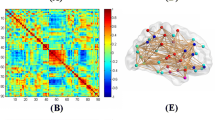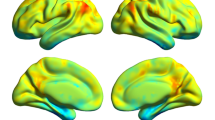Abstract
Objectives
To investigate structural brain connectome alterations in cirrhotic patients with prior overt hepatic encephalopathy (OHE).
Methods
Seventeen cirrhotic patients with prior OHE (prior-OHE), 18 cirrhotic patients without prior OHE (non-prior-OHE) and 18 healthy controls (HC) underwent diffusion tensor imaging. Neurocognitive functioning was assessed with Psychometric Hepatic Encephalopathy Score (PHES). Using a probabilistic fibre tracking approach, we depicted the whole-brain structural network as a connectivity matrix of 90 regions (derived from the Automated Anatomic Labeling atlas). Graph theory-based analyses were performed to analyse topological properties of the brain network.
Results
The analysis of variance showed significant group effects on several topological properties, including network strength, global efficiency and local efficiency. A progressive decrease trend for these metrics was found from non-prior-OHE to prior-OHE, compared with HC. Among the three groups, the regions with altered nodal efficiency were mainly distributed in the frontal and occipital cortices, paralimbic system and subcortical regions. The topological metrics, such as network strength and global efficiency, were correlated with PHES among cirrhotic patients.
Conclusions
The cirrhotic patients developed structural brain connectome alterations; this is aggravated by prior OHE episode. Disrupted topological organization of the brain structural network may account for cognitive impairments related to prior OHE.
Key points
• Altered structural brain connectome is found in cirrhotic patients.
• Structural brain connectome alterations could be aggravated by prior-OHE episode.
• Altered structural brain connectome may account for cognitive impairments associated with prior OHE.





Similar content being viewed by others
Abbreviations
- AAL:
-
Automated Anatomical Labeling
- ACG:
-
Anterior cingulate and paracingulate gyri
- AUC:
-
Area under the curve
- DCG:
-
Median cingulate and paracingulate gyri
- DMN:
-
Default mode network
- DST:
-
Digit symbol test
- DTI:
-
Diffusion tensor imaging
- IFGtriang:
-
Inferior frontal gyrus-triangular part
- IOG:
-
Inferior occipital gyrus
- LTT:
-
Line tracing test
- MMSE:
-
Mini-Mental State Examination
- NCT-A:
-
Number connection test A
- NCT-B:
-
Number connection test B
- OHE:
-
Overt hepatic encephalopathy
- ORBinf:
-
Inferior frontal gyrus-orbital part
- ORBsup:
-
Superior frontal gyrus-orbital part
- PCG:
-
Posterior cingulate gyrus
- PCL:
-
Paracentral lobule
- PHES:
-
Psychometric Hepatic Encephalopathy Score
- REC:
-
Gyrus rectus
- SDT:
-
Serial dotting test
- SFGdor:
-
Dorsolateral superior frontal gyrus
- SFGmed:
-
Medial superior frontal gyrus
- SMA:
-
Supplementary motor area
- SOG:
-
Superior occipital gyrus
- STG:
-
Superior temporal gyrus
- WM:
-
White matter
References
Tsochatzis EA, Bosch J, Burroughs AK (2014) Liver cirrhosis. Lancet 383:1749–1761
Stepanova M, Mishra A, Venkatesan C, Younossi ZM (2012) In-hospital mortality and economic burden associated with hepatic encephalopathy in the United States from 2005 to 2009. Clin Gastroenterol Hepatol 10(1034-1041), e1031
Bustamante J, Rimola A, Ventura PJ et al (1999) Prognostic significance of hepatic encephalopathy in patients with cirrhosis. J Hepatol 30:890–895
Bajaj JS, Schubert CM, Heuman DM et al (2010) Persistence of cognitive impairment after resolution of overt hepatic encephalopathy. Gastroenterology 138:2332–2340
Umapathy S, Dhiman RK, Grover S, Duseja A, Chawla YK (2014) Persistence of cognitive impairment after resolution of overt hepatic encephalopathy. Am J Gastroenterol 109:1011–1019
Riggio O, Ridola L, Pasquale C et al (2011) Evidence of persistent cognitive impairment after resolution of overt hepatic encephalopathy. Clin Gastroenterol Hepatol 9:181–183
Bajaj JS, Heuman DM, Sterling RK et al (2015) Validation of EncephalApp, smartphone-based Stroop test, for the diagnosis of covert hepatic encephalopathy. Clin Gastroenterol Hepatol 13(1828-1835), e1821
Bajaj JS, Thacker LR, Heuman DM et al (2013) The Stroop smartphone application is a short and valid method to screen for minimal hepatic encephalopathy. Hepatology 58:1122–1132
Allampati S, Mullen KD (2014) Does overt hepatic encephalopathy cause persistent cognitive defects even after successful liver transplantation? Liver Transpl 20:874–875
Campagna F, Montagnese S, Schiff S et al (2014) Cognitive impairment and electroencephalographic alterations before and after liver transplantation: what is reversible? Liver Transpl 20:977–986
Sotil EU, Gottstein J, Ayala E, Randolph C, Blei AT (2009) Impact of preoperative overt hepatic encephalopathy on neurocognitive function after liver transplantation. Liver Transpl 15:184–192
Frederick RT (2012) Extent of reversibility of hepatic encephalopathy following liver transplantation. Clin Liver Dis 16:147–158
Guevara M, Baccaro ME, Gomez-Anson B et al (2011) Cerebral magnetic resonance imaging reveals marked abnormalities of brain tissue density in patients with cirrhosis without overt hepatic encephalopathy. J Hepatol 55:564–573
Chen HJ, Wang Y, Zhu XQ, Cui Y, Chen YC, Teng GJ (2012) White matter abnormalities correlate with neurocognitive performance in patients with HBV-related cirrhosis. J Neurol Sci 321:65–72
Butterworth R (2007) Neuronal cell death in hepatic encephalopathy. Metab Brain Dis 22:309–320
Bressler SL, Menon V (2010) Large-scale brain networks in cognition: emerging methods and principles. Trends Cogn Sci 14:277–290
Barkhof F, Haller S, Rombouts SA (2014) Resting-state functional MR imaging: a new window to the brain. Radiology 272:29–49
Bullmore E, Sporns O (2009) Complex brain networks: graph theoretical analysis of structural and functional systems. Nat Rev Neurosci 10:186–198
Zhang L, Qi R, Wu S et al (2012) Brain default-mode network abnormalities in hepatic encephalopathy: a resting-state functional MRI study. Hum Brain Mapp 33:1384–1392
Jao T, Schroter M, Chen CL et al (2015) Functional brain network changes associated with clinical and biochemical measures of the severity of hepatic encephalopathy. Neuroimage 122:332–344
Chen HJ, Jiao Y, Zhu XQ et al (2013) Brain dysfunction primarily related to previous overt hepatic encephalopathy compared with minimal hepatic encephalopathy: resting-state functional MR imaging demonstration. Radiology 266:261–270
Griffa A, Baumann PS, Thiran JP, Hagmann P (2013) Structural connectomics in brain diseases. Neuroimage 80:515–526
Ferenci P, Lockwood A, Mullen K, Tarter R, Weissenborn K, Blei AT (2002) Hepatic encephalopathy–definition, nomenclature, diagnosis, and quantification: final report of the working party at the 11th World Congresses of Gastroenterology, Vienna, 1998. Hepatology 35:716–721
Chen HJ, Jiang LF, Sun T, Liu J, Chen QF, Shi HB (2015) Resting-state functional connectivity abnormalities correlate with psychometric hepatic encephalopathy score in cirrhosis. Eur J Radiol 84:2287–2295
Herskovits EH, Hong LE, Kochunov P, Sampath H, Chen R (2015) Edge-centered DTI connectivity analysis: application to schizophrenia. Neuroinformatics 13:501–509
Rubinov M, Sporns O (2010) Complex network measures of brain connectivity: uses and interpretations. Neuroimage 52:1059–1069
Bai F, Shu N, Yuan Y et al (2012) Topologically convergent and divergent structural connectivity patterns between patients with remitted geriatric depression and amnestic mild cognitive impairment. J Neurosci 32:4307–4318
Korgaonkar MS, Fornito A, Williams LM, Grieve SM (2014) Abnormal structural networks characterize major depressive disorder: a connectome analysis. Biol Psychiatry 76:567–574
Hahn A, Kranz GS, Kublbock M et al (2015) Structural connectivity networks of transgender people. Cereb Cortex 25:3527–3534
Lei D, Li K, Li L et al (2015) Disrupted functional brain connectome in patients with posttraumatic stress disorder. Radiology 276:818–827
Hsu TW, Wu CW, Cheng YF et al (2012) Impaired small-world network efficiency and dynamic functional distribution in patients with cirrhosis. PLoS One 7, e35266
Chen HJ, Zhu XQ, Shu H et al (2012) Structural and functional cerebral impairments in cirrhotic patients with a history of overt hepatic encephalopathy. Eur J Radiol 81:2463–2469
Buckner RL, Andrews-Hanna JR, Schacter DL (2008) The brain's default network: anatomy, function, and relevance to disease. Ann N Y Acad Sci 1124:1–38
Fox MD, Snyder AZ, Vincent JL, Corbetta M, Van Essen DC, Raichle ME (2005) The human brain is intrinsically organized into dynamic, anticorrelated functional networks. Proc Natl Acad Sci U S A 102:9673–9678
Tao R, Zhang J, You Z et al (2013) The thalamus in cirrhotic patients with and without hepatic encephalopathy: a volumetric MRI study. Eur J Radiol 82:e715–720
Qi R, Zhang LJ, Zhong J et al (2013) Disrupted thalamic resting-state functional connectivity in patients with minimal hepatic encephalopathy. Eur J Radiol 82:850–856
Zhang LJ, Zheng G, Zhang L et al (2012) Altered brain functional connectivity in patients with cirrhosis and minimal hepatic encephalopathy: a functional MR imaging study. Radiology 265:528–536
Haber SN, Calzavara R (2009) The cortico-basal ganglia integrative network: the role of the thalamus. Brain Res Bull 78:69–74
Ball G, Pazderova L, Chew A et al (2015) Thalamocortical connectivity predicts cognition in children born preterm. Cereb Cortex 25:4310–4318
Hope T, Westlye LT, Bjornerud A (2012) The effect of gradient sampling schemes on diffusion metrics derived from probabilistic analysis and tract-based spatial statistics. Magn Reson Imaging 30:402–412
Vaessen MJ, Hofman PA, Tijssen HN, Aldenkamp AP, Jansen JF, Backes WH (2010) The effect and reproducibility of different clinical DTI gradient sets on small world brain connectivity measures. Neuroimage 51:1106–1116
Zalesky A, Fornito A, Harding IH et al (2010) Whole-brain anatomical networks: does the choice of nodes matter? Neuroimage 50:970–983
Chavarria L, Alonso J, Garcia-Martinez R et al (2011) Biexponential analysis of diffusion-tensor imaging of the brain in patients with cirrhosis before and after liver transplantation. AJNR Am J Neuroradiol 32:1510–1517
Mardini H, Smith FE, Record CO, Blamire AM (2011) Magnetic resonance quantification of water and metabolites in the brain of cirrhotics following induced hyperammonaemia. J Hepatol 54:1154–1160
Author information
Authors and Affiliations
Corresponding authors
Ethics declarations
Guarantor
The scientific guarantor of this publication is Hua-Jun Chen.
Conflict of interest
The authors of this manuscript declare no relationships with any companies whose products or services may be related to the subject matter of the article.
Funding
This study has received funding by the National Natural Science Foundation of China (No. 81501450) and the China Postdoctoral Science Foundation
Statistics and biometry
No complex statistical methods were necessary for this paper.
Informed consent
Written informed consent was obtained from all subjects (patients) in this study.
Ethical approval
Institutional review board approval was obtained.
Methodology
•retrospective
•cross-sectional study
•performed at one institution
Electronic supplementary material
Below is the link to the electronic supplementary material.
ESM 1
(DOCX 74.8 kb)
Supplementary Figure 6
(GIF 9.38 kb)
Supplementary Figure 7
(GIF 11.4 kb)
Supplementary Figure 8
(GIF 10.2 kb)
Supplementary Figure 9
(GIF 10.7 kb)
Supplementary Figure 10
(GIF 12.1 kb)
Supplementary Figure 11
(GIF 44.7 kb)
Supplementary Figure 12
(GIF 422 kb)
Supplementary Figure 13
(GIF 411 kb)
Rights and permissions
About this article
Cite this article
Chen, HJ., Shi, HB., Jiang, LF. et al. Disrupted topological organization of brain structural network associated with prior overt hepatic encephalopathy in cirrhotic patients. Eur Radiol 28, 85–95 (2018). https://doi.org/10.1007/s00330-017-4887-8
Received:
Revised:
Accepted:
Published:
Issue Date:
DOI: https://doi.org/10.1007/s00330-017-4887-8




